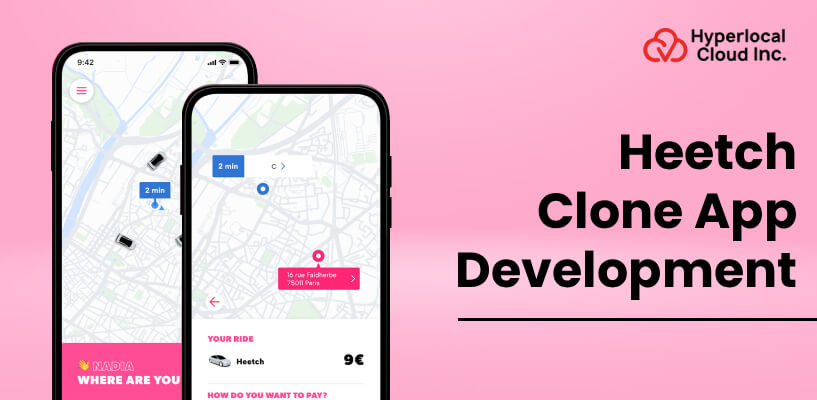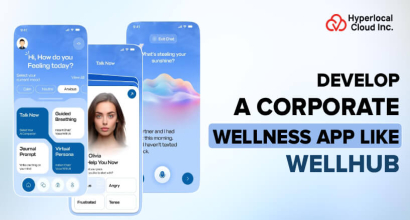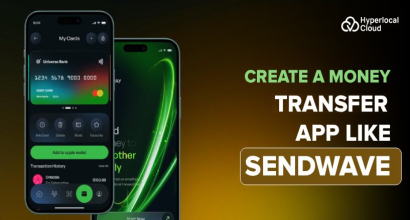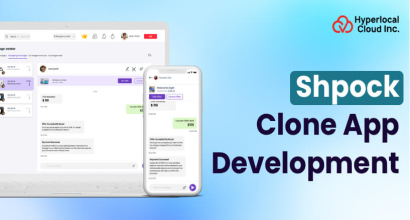The rideshare industry is steadily growing, and it's likely that within a few years, the global market will see significant growth. As mobile bookings are taking over urban transport and the demand for flexible mobility solutions increases, by starting up with your own ride-sharing platform, you will be at the center of the new transportation revolution.
According to Precedence Research, the global ridesharing market size was estimated to be $126.46 billion in 2024, and it is expected to exceed $691.63 billion by 2034, with a CAGR of 18.52% from 2025 to 2034. Entering this lucrative market, a Heetch clone app will enable you to offer low-cost and community-like services, particularly rides, to younger users and at night.
Let's explore how this application works and how you can develop one to grow your brand!
Understanding The Heetch Application
The Heetch app is one of the ride-hailing applications, like Uber, which offers VTC (Vehicle for Hire), LVC (Light Vehicle for Hire), and taxi services. The app allows users to book rides to navigate their city and has such features as real-time driver tracking, price estimates, and a range of payment options, such as credit, debit, and prepaid cards. In a number of countries in Europe, Africa, and the Middle East, it provides service 24/7, and it is an option to travel when the normal means of transportation are not convenient.
Fast & Reliable Heetch Clone Development
Step-by-Step Working Model Of Heetch Clone App
The following are the ways in which the Heetch clone app works for the rider and driver:
1. The Rider Registers & Requests a Trip
Rider Registration: The rider downloads the application and signs up for the app by providing the required details. After entering all the essential data, the rider can move further to the booking process.
Enter details: The rider opens the app and types in his/her destination. The app will take the GPS position of the rider as a pickup point.
View fare estimate: The app gives an estimated fare depending on distance, time, and real-time demand. The final cost is open and fixed prior to confirmation of the ride.
Choose a ride: Firstly, the rider should define the purpose of the trip and the budget. Consequently, he/she can choose from a variety of vehicles like classics, premium, and vans, the most appropriate one.
Book the ride: A rider provides all necessary details and makes required selections, then the rider confirms the ride by tapping it.
2. The Driver Accepts the Request
Receive notification: The app system is based on an equivalent algorithm in order to pass the request for the ride to the closest professional driver on the road.
Accept or decline: The app provides the driver with whom it is, by accepting the ride or denying the request, as described by his/her availability and location options.
Navigate to pickup: The driver is given the direction of the pick-up location with the help of the GPS in the app when he/she accept it.
3. The Trip is Conducted
Confirmation: The OTP (one-time password) feature enables riders and drivers to mutually confirm each other's identity without any trouble when the driver reaches the location.
Real-time tracking: The rider is able to view the trip in progress on a map, in real time. They would also be able to share with friends their location for safety.
Arrival at destination: The app is leading the driver to the point of drop off that is mentioned in the particular destination.
4. Payment and Feedback
Automated payment: In case of card payment, the payment will be made automatically in the app at the end of the trip.
Feedback: The riders and drivers can rate each other using the feedback option in the app. They can also add a review about the quality of the ride and other aspects.
Key Business Advantages Of Developing A Heetch Clone App
The businesses can build a ride-sharing app like Uber or Heetch to get a quick market entrance, as it uses the existing successful model, which is also cost-effective. Here are the reasons why businesses or startups should invest:
1. Cost-effectiveness
It is less expensive and time-consuming for businesses that want to invest in a ride-hailing application, as it is already a successful model. Thus, it lowers the start-up costs for the businesses.
2. Rapid market entry
A clone will enable startups to access the competitive ride-sharing market at a rapid pace, taking advantage of the high demand for ride-hailing services.
3. Targeted niche focus
The ride-hailing app, like Heetch, is to provide night rides to young adults, which can be modified to meet the needs of a specific group of users or address a concrete transportation issue, such as the unavailability of night-time rides.
4. Scalability and flexibility
Clone app can be upgraded with superior features and adapted with new technologies such as AI, MLA, and NLP to comply with the changing business requirements and market trends.
5. Simplified operations
Simple operations can be easily managed with a powerful administration dashboard that can manage driver activities, user interactions, and business metrics.
6. Leveraging proven success
A clone is built upon the proven success of an existing platform, and thus, the potential risk of a new service introduction is lower.
Essential Features To Include In The Heetch Clone Application
If any business is investing in developing a ride-sharing app like Popparide or Heetch, it should include the following features to facilitate the different panels:
Customer Panel
1. User profile
User profile is a feature that enables users to create profiles of their own. A user can input basic information consisting of the name, email, and phone number.
2. Ride booking
The ride booking feature allows users to conveniently book rides of various vehicle types (for example, VTC, LVC, taxi) based on their needs.
3. GPS tracking
This feature allows users to see the driver's location in real time on the map and track his or her route.
4. Fare estimation
This feature helps riders get the estimated ride fare before booking and live updates on the ride.
5. Payment options
Pay with a credit card or the in-app wallet; the app also offers UPI payments, and cash payments are accepted.
6. Ride history
It allows riders to get an overview of where they have been before, including billing and driver details.
7. Driver profile & ratings
See the information about the drivers, such as name, photo, and rating, with the aim of making the right decisions.
8. Push notifications
The push notifications feature keeps the users notified of the status of their trip in real time.
9. In-app chat
The in-app chat feature allows riders to interact with their driver about the location and other details without any trouble.
10. 24/7 support
This feature offers riders 24/7 support. If the user needs support in any case, he/she can use this feature and connect to the respective team.
Driver Panel
1. Profile & vehicle management
The drivers can create their profile on the app by providing the required documents, such as a driver's license, etc.
2. Ride acceptance/decline
The drivers have the option of accepting or rejecting ride requests as they appear on the app, as per their convenience.
3. Real-time tracking & navigation
Built-in GPS guides drivers to the point where the passenger is picked up and their destination.
4. Trip history
Using the trip history feature, the driver can view the previous trips, distance, time, and fare information.
5. Earnings tracker
The earning tracker allows drivers to track their earnings, income history, and performance statistics.
6. Invoice details
The drivers can easily get the detailed invoices on a post-ride basis using the invoice details feature.
7. 24/7 support team
The drivers can reach out to the support team in case of any issues, and the team will assist with any problems or questions.
8. Multi-vehicle option
This is an option whereby the drivers can provide a number of vehicle choices to passengers depending on their needs.
Admin Panel
1. User profiles
The admin can see and redeem wallet balances, ride history, and contact information of riders and drivers.
2. Driver verification
Using this feature, the admin can check driver records, licenses, and car details to ascertain providence.
3. Booking management
Manage all bookings, such as their status (completed, canceled, pending), and properties such as fare, payment, and distance.
4. Live ride tracking
The admin can view the rides and the movements of the drivers in real-time using the live ride tracking feature.
5. Earning reports
Produce detailed reports about driver earnings, commissions, subscriptions, and other payment transactions.
6. Push notifications
The admin can send push messages to drivers and riders whenever there is a new release of updates and offers.
7. Promo codes
The admin can develop and control promo codes with a flat or percentage discount to attract customers.
8. Support tickets
Using the support tickets feature, the admin can click the tickets that have been raised in order to fix problems.
9. Reports & analytics
Using this feature, the admin can create user data, ride status, payment mode, driver activity, and cancellation reports.
Own the Ride-Sharing Market With Heetch Clone Now!
AI-Powered Features That Can Be Integrated Into The Heetch Clone App
Businesses can integrate the following AI-driven features into the app. It will help them enhance the user experience:
1. Intelligent ride matching
AI would not just match a driver with the nearest one, but it would evaluate various factors to come up with a smart match. This may consist of the destination of the rider, traffic congestion, estimated pickup time, and ratings of drivers to enhance the success of the trip and decrease wait time.
2. Predictive demand forecasting
It is based on historical and real-time data that allows AI to predict the rise in demand alongside the times of the day and night when the demand will rise based on factors such as holidays, weather, or local events. This will help the app show the drivers the heatmap, motivating them to relocate to the high-demand regions to address the expected requests, decrease idle time, and maximize their earnings.
3. Dynamic pricing engine
Although the concept of surge pricing can be controversial, AI-driven systems can produce real-time changes in fares using a more balanced comparison of demand, supply, traffic, and external events. This will motivate a large number of drivers to operate during the peak hours and provide transparent pricing that is sensitive to market conditions.
4. Fraud detection and prevention
To fight the fake accounts, GPS spoofing, and suspicious patterns of payments, AI and machine learning algorithms analyze the activity in real-time. This will allow avoiding either financial or reputational losses to the business and foster trust with the users.
5. Voice-enabled assistants
Voice-enabled assistants allow users to place a ride, monitor the status of their trips, or acquire assistance through easy voice commands, which is safer and allows users to use their hands-free.
A Complete Development Roadmap To Develop A Heetch Clone App
The businesses that want to know how the ride-sharing app like Heetch is developed, they should follow the steps below:
1. Ideation & market research
This stage entails familiarizing oneself with the target market, competitor analysis, and market gap identification. This will assist businesses in ascertaining their USP and make their application accurate.
2. Planning and strategy
After doing all the necessary market research, it is now required to plan out a detailed project in this phase. This plan will include all the necessary details, such as the functionality and features that the app will include. It will also include the milestone deadlines for the different phases of development.
3. Design and prototyping
At this stage, the designer produces mock-ups/working samples that illustrate the flow of the app, the layout of the screens, and the users' interactions to gather comments on what may be modified and how. Next, designers collaborate to produce the most effective UI/UX experience, which not only allows users to navigate easily through the app but also allows them to readily book and engage.
4. Development
The developers generally used two ways to develop the application. One is custom-based, and the other is a white-label solution. Here is a comparison table of how these two differ:
| Feature | Custom-Based Solution | White Label Solution |
| Development Time | Takes 4-8 months to build from scratch | Ready in 1-2 weeks, already built |
| Cost | Higher cost | Lower cost |
| Customization | Fully customizable, built exactly as you want | Limited changes, pre-made features |
| Unique Features | Can add any special features you need | Comes with standard features only |
| Ownership | You own the complete source code | You get a license to use the product |
5. Quality assurance
After the successful development of the app, it is now time for the QA team to identify and eliminate the bugs. Besides, it increases the performance level and assures application compatibility with different devices. The different kinds of testing, examples are unit, penetration, and integration, are carried out to guarantee a user-end experience of the highest quality.
6. Deployment and Marketing
After the app is tested for bugs and the errors are fixed, the app is launched on the dedicated app stores like Google Play Store and Apple App Store. Now, businesses can create a marketing strategy that will help them attract users. In this way, businesses can spread the app efficiently in the market.
Choosing The Right Technology Stack For The Heetch Clone App Development
For a Heetch clone app development, it is necessary to select the appropriate technology stack. The technologies involved in the development are the following:
| Category | Technology |
| Frontend | React Native, React.js |
| Backend | Node.js, Express.js, Socket.io |
| Database | PostgreSQL, Redis, MongoDB |
| Payment Gateway | Stripe, Razorpay, PayPal |
| Cloud Platforms | AWS, Google Cloud Platform |
| Push Notifications | Firebase Cloud Messaging (FCM) |
| APIs | Google Maps API, Twilio, SendGrid |
Monetization Strategies For Turning The Heetch Clone Into Profit
In order to earn a profit with the Heetch clone app, which is more or less a ride-hailing service, there are a number of strategies that can be used to increase income. They are mainly based on the essence of the service that links riders and drivers:
1. Commission on Rides
The first and most prevalent source of revenue is a percentage commission of each ride that is booked using the app. This is the model that most ride-hailing services, such as Heetch use. The commission rate may be modified as per the market conditions, competition, and to achieve the desired driver incentives.
2. Surge Pricing/Dynamic Pricing
The dynamic pricing model offers an automated price adjustment of the fare prices when the demand is high (e.g., peak hours, bad weather, special events) or when there is a low supply of drivers. This boosts the amount of revenue on a ride through such periods and motivates more drivers to work.
3. Subscription Models
Provide superior subscriptions to customers or drivers. To the users, this may be inclusive of some benefits such as discounted rides, priority booking, or even special access to some vehicles. To drivers, the subscriptions may have reduced commission, access to more sophisticated capabilities, or a priority to be assigned the ride request.
4. In-App Advertising
Build ads into the app, where the user or driver views the relevant ads. This might be banner advertisements, in-between advertising, or sponsored local business content.
5. Partnerships and Collaborations
Identify local restaurants, entertainment, or shopping destinations where you will offer app users exclusive discounts or incentives, which could potentially lead to a referral fee from your local partner's advertising revenue.
6. Additional Services
Expand your business to other services other than ride-hailing and provide other services on your driver network:
Delivery: Deliver on-demand foods, groceries, packages, or any other goods using your own driver pool.
Vehicle Rentals: Through the app, businesses are also able to make profits by renting their vehicles to be used in the short term.
Join the Ride-Sharing Revolution with a Heetch Clone
How Much Does It Cost To Build A Heetch Clone App?
The cost to build a ride-sharing app like Heetch starts from $5,000. Hyperlocal Cloud, a taxi booking app development company, offers customers future-proof solutions. There are several factors that affect the cost of development of the ride-sharing app like Heetch, these are as follows:
- Latest technology stacks
- Integrated functionalities and features
- Application complexity
- Developer location and availability
- User interface (UI) and user experience (UX) design
- Development firm size and team structure
- Software development process and methodology
Partner with Hyperlocal Cloud: Your Trusted Ride-Sharing App Development Expert
Hyperlocal Cloud is a ride-sharing app development company that offers businesses of all sizes with our affordable and scalable solutions to help them grow. Here are the reasons that make us stand out from other custom software development companies:
- On-time project delivery
- 24/7 customer assistance
- Clear and transparent pricing
- Experienced developers
- Cost-effective solutions
- Customizable options
- Demonstrated success and results



